Skating
"The great outdoor recreation of the winter season in our northern clime is,
undoubtedly, the invigorating and exciting exercise of skating."
Ice skating was America's first national winter sports craze. When New York City's Central Park opened in 1858, it became a fashionable pastime—both for men and for ladies who wanted to keep "up with the times." Soon, all classes and ages of Americans were taking to the ice—on country ponds, in small-town parks, and at indoor rinks.
By 1879, roller skating was considered a perfect alternative to ice skating—especially for those times when the ice was too rough or too soft, or when "the keen blasts of the winter's wind are too severe." Roller skating would become a huge craze in the 1880s, when almost every city and town had its rink.
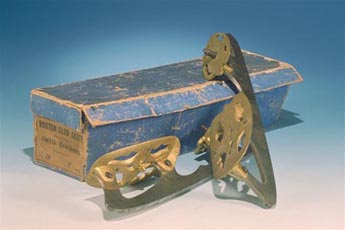
Early factory-made ice skates, made during the late
1860s by Smith Brothers, Boston, Massachusetts.
ID.25.144.1 |
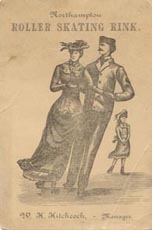
1881 trade card advertising
the roller-skating rink in Northampton, Massachusetts. ID.87.7.1.1 |
Curling
"Curling is a game worthy of the hardy Scots, calling into play…most of the
characteristics of manliness…"
In the sport of curling, teams of players slide slightly-flattened, round granite stones to a designated spot on the ice. From Scotland, curling spread to Canada—where it took permanent hold. Although this sport showed sure signs of popularity here in the 1870s, it would never have as passionate a following as it did in Canada.

Match between Scottish and American curlers at
Cortlandt Lake, Westchester County, New York,
from Harper's Weekly, February 9, 1884.
Ice-Boating
"…for thrilling excitement [ice-boating] surpasses every other [sport] in vogue."
Ice-boating probably originated in the Netherlands, where frozen canals and lakes became speedy highways during the winter months. This sport's early popularity in America centered around the Hudson River, where ice-boating became a mass spectator sport during the 1870s. Simple ice boats evolved into great ice "yachts"—designed for stability and speed.
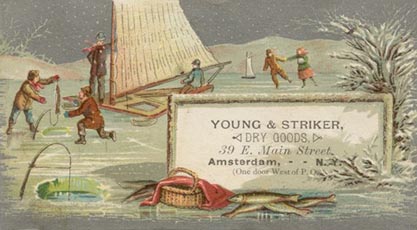
Ice-boating is part of this idyllic winter scene, from a trade card for
the
Young & Striker dry
goods store in Amsterdam, New York, around 1890.
ID.87.7.2.1
Football
"The game of football is called the 'national winter game' in England, because it is played there throughout the winter season."
Americans don't generally think of football as a winter game. Even Chadwick admitted that, "in all but the Southern states, it can only be played during a portion of the winter season, when the snow is off the ground." But by 1879, football was showing definite promise as an up-and-coming American sport. So Chadwick seized the opportunity to document its rules and publish the first known diagram of an American football field in this handbook.
Football, which evolved from the English game of rugby, first became popular as a collegiate sport. The rules of play for the American version of football continued to evolve into the 20th century. Professional football would not come of age until the 1920s.
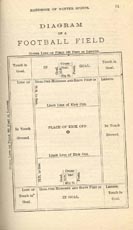
This is the first known
diagram of an American
football field,
pictured in
the 1879 "Hand Book of
Winter Sports." ID.2006.11.1
Gift of Matt Millen
|
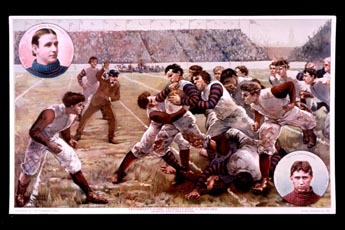
This 1897 football game shows the rough nature of the
sport
at the time, predating the use of helmets and padding.
ID.86.14.4.1
|
What's Missing from the 1879 Hand Book?

Cover of the 1932 Winter
Olympics
program
in Lake
Placid, featuring the exciting
bobsled competition. ID.86.13.40.1
Gift of Donna R. Braden |
So what about the winter sports we think of today—like basketball, hockey and skiing?
Basketball was devised at a Y.M.C.A. in 1891, as a way to keep athletes in shape over the winter months. This sport quickly spread to school physical education programs for both boys and girls. It did not go professional until 1946.
Skiing was brought to America by Scandinavian immigrants during the late 19th century. Ice hockey came to the United States as an organized sport from Canada during the 1890s. Amateur, youth, and collegiate teams were popular before professional ice hockey gained a national following during the 1920s.
More than any other sports event, the international Winter Olympics (begun in 1924) heightened Americans' interest and enthusiasm for winter sports—especially after the Olympics came to Lake Placid, New York, in 1932.
Then and Now
The pastimes and sports described in the 1879 "Hand Book" laid the foundation for Americans' passion for winter sports. Many winter sports became faster and more competitive. They came to be played by men and women of all ages, and they provided outlets for people from many different walks of life.
Some winter sports—like football, basketball and hockey—have become mass spectator sports. However, many others—like sledding, skating and snowshoeing—still provide opportunities for healthful recreation and, as Chadwick put it back in 1879, "a wonderful power of exhilaration attendant upon breathing the pure oxygen of a winter atmosphere."
-- Donna R. Braden, Curator of Public Life |

